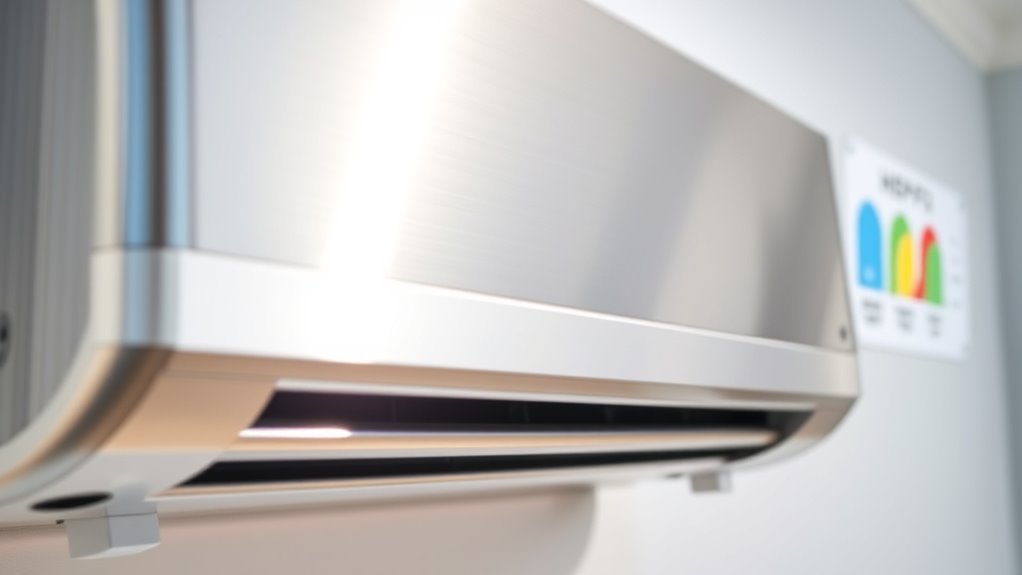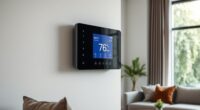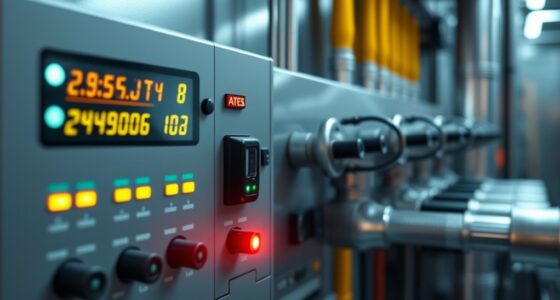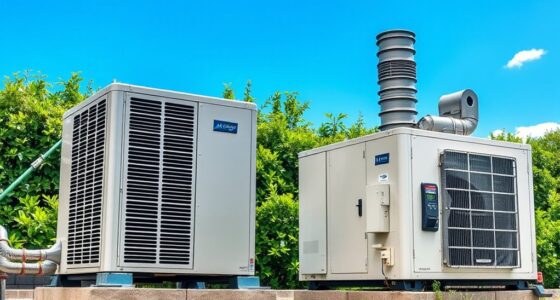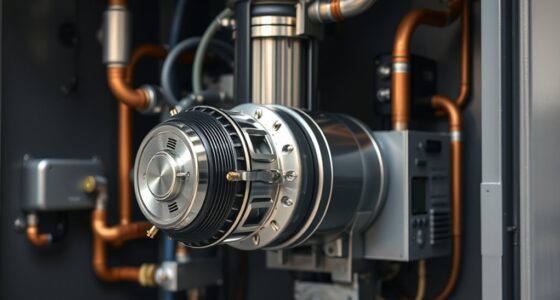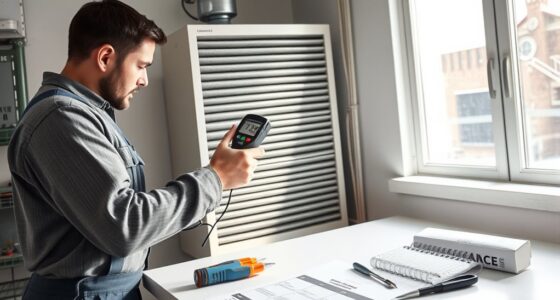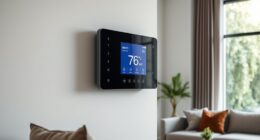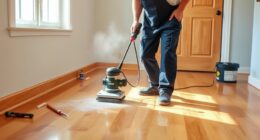Understanding SEER and HSPF ratings helps you see how efficiently your HVAC system performs over a full season. A higher SEER means better cooling efficiency during summer, while a higher HSPF indicates more efficient heating in winter. These ratings can guide you to choose units that save money on energy bills and provide consistent comfort year-round. If you want to make smarter choices and maximize energy savings, there’s more to discover about what these ratings really mean.
Key Takeaways
- SEER measures air conditioner efficiency over a cooling season, while HSPF assesses heat pump efficiency during heating.
- Higher SEER and HSPF ratings indicate greater energy efficiency and lower long-term operating costs.
- Ratings reflect performance across entire seasons, ensuring consistent comfort and efficiency during temperature fluctuations.
- Upfront costs increase with higher ratings, but energy savings over time often offset initial expenses.
- Understanding these ratings helps compare systems, choose suitable units, and optimize energy use for better savings.
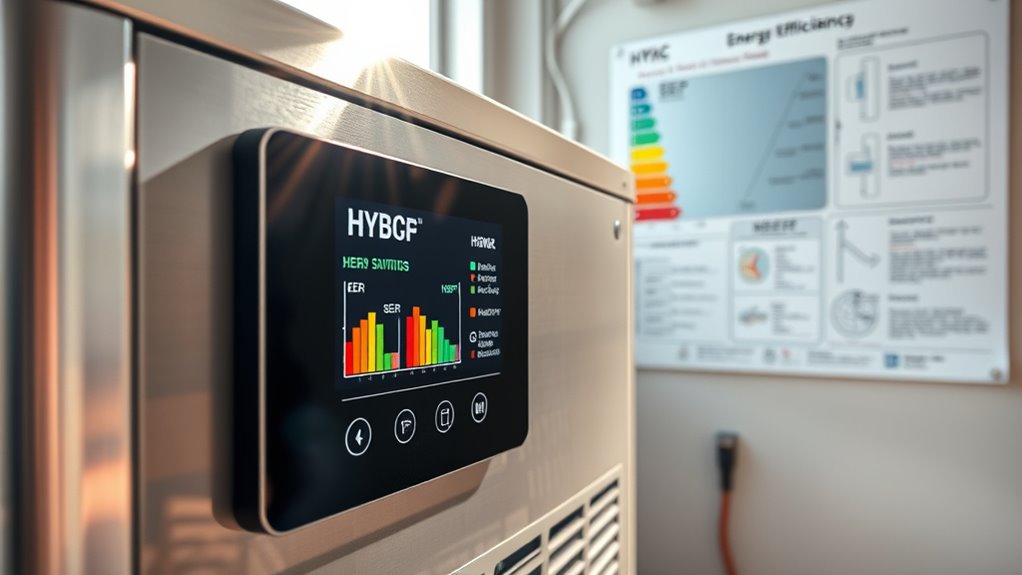
When choosing an air conditioning or heat pump system, understanding SEER and HSPF ratings is essential because they directly impact your energy efficiency and long-term costs. These ratings help you compare different units’ performance, giving you a clearer picture of how well they operate across varying conditions. SEER, or Seasonal Energy Efficiency Ratio, measures how efficiently an air conditioner cools your space over an entire cooling season. The higher the SEER number, the more efficient the system, meaning it uses less electricity to remove the same amount of heat. HSPF, or Heating Seasonal Performance Factor, functions similarly but applies to heat pumps during the heating season. It indicates how effectively the heat pump generates heat relative to the energy it consumes. Additionally, understanding the analgesic properties of essential oils can help you choose products that support your overall comfort and well-being.
Understanding SEER and HSPF ratings helps you choose energy-efficient heating and cooling systems for long-term savings.
When you’re evaluating different systems, a key aspect to contemplate is the cost comparison. Higher SEER and HSPF ratings typically come with a higher upfront price, but they often lead to lower operating costs over time. Systems with better seasonal performance consume less energy during peak usage, which can translate into significant savings on your energy bills. For example, a heat pump with an HSPF of 10 will be less efficient than one with an HSPF of 13, costing you more in the long run if you run it frequently during the winter months.
Seasonal performance is another critical factor. These ratings are designed to reflect how the equipment performs across an entire season, not just in ideal conditions. A unit with a high SEER or HSPF rating will maintain its efficiency during extreme weather or fluctuating temperatures better than a lower-rated system. This means you can expect consistent comfort without spikes in energy use, even during the hottest summer days or coldest winter nights.
It’s important to look beyond the initial purchase price and focus on the overall energy savings and comfort that a high-rated system can provide. While a unit with a higher SEER or HSPF may seem more expensive upfront, the reduced energy consumption can make it a smarter long-term investment. You’ll notice this difference most during seasonal shifts, when the system works harder to keep your home comfortable. By understanding these ratings, you’re better equipped to select a system that balances cost, efficiency, and seasonal performance, ultimately saving you money and enhancing your comfort year-round.
Frequently Asked Questions
How Do SEER and HSPF Ratings Impact Your Monthly Energy Bills?
Higher SEER and HSPF ratings mean your HVAC system is more energy-efficient, leading to significant energy savings on your monthly bills. When your system operates efficiently, it consumes less electricity while providing the same level of comfort. By choosing equipment with better ratings, you guarantee your system runs at its best, reducing energy costs and enhancing overall system efficiency, which keeps more money in your pocket each month.
Can Higher Ratings Lead to Significant Long-Term Savings?
Think of higher SEER and HSPF ratings as a well-tuned engine that keeps your energy costs in check. Yes, they can lead to significant long-term savings by making your HVAC system more efficient, reducing your energy bills over time. Investing in higher-rated equipment is like planting a seed that grows into big savings, helping you cut costs and enjoy lower energy expenses for years to come.
Are There Regional Differences in Optimal SEER and HSPF Ratings?
Yes, regional climate and local regulations influence ideal SEER and HSPF ratings. In hotter regions, higher SEER ratings help you save more on cooling costs, while in milder climates, lower ratings might suffice. Local regulations can also mandate minimum efficiency standards, guiding you toward specific ratings. You should consider your area’s climate and rules to choose the most efficient system, maximizing savings and comfort.
Do Higher Ratings Affect the Upfront Cost of HVAC Systems?
Higher ratings are like investing in quality tools—they may cost more upfront, but they save you money in the long run. Yes, systems with better SEER and HSPF ratings tend to have higher upfront costs, impacting system affordability. However, these efficient units reduce energy bills and maintenance, making them a smarter choice over time. So, while initial costs are higher, the overall savings make it a worthwhile investment.
How Often Should You Consider Upgrading Your System Based on Ratings?
You should consider upgrading your HVAC system when it no longer meets your energy efficiency goals or if it’s no longer covered under warranty requirements. Regular maintenance helps identify performance issues early, but if your system’s SEER and HSPF ratings are outdated, upgrading can save you money long-term. Typically, plan for an upgrade every 10-15 years, especially if efficiency declines despite following your maintenance schedule.
Conclusion
Understanding SEER and HSPF ratings helps you make smarter energy choices, but remember, higher ratings aren’t just numbers—they’re your savings and comfort in disguise. While a high SEER cools your home efficiently, a high HSPF warms your wallet with lower energy bills. Don’t just chase the highest numbers; balance ratings with your needs. Because in the end, choosing the right system isn’t just about efficiency—it’s about creating a comfortable, cost-effective living space you can count on.
